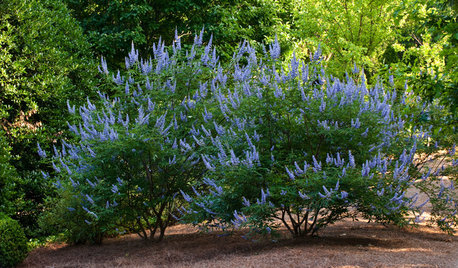Invasives forum?
agkistrodon
10 years ago
Related Stories

GARDENING GUIDES6 Plants That Beat Butterfly Bush for the Wildlife Draw
It's invasive, a nonnative and a poor insect magnet. Check out these better alternatives to butterfly bush in the garden
Full Story
BATHROOM DESIGNHow to Choose Tile for a Steam Shower
In steamy quarters, tile needs to stand up to all that water and vapor in style. Here's how to get it right the first time
Full Story
FLOWERS AND PLANTSVitex Agnus-Castus Fills Gardens With Fragrant Blooms and Foliage
Spikes of purple flowers adorn chaste tree’s aromatic foliage throughout the warm season in Southern gardens
Full Story
GARDENING AND LANDSCAPINGGrow a Lush Privacy Screen
No need to wait forever for patio privacy the green way. These 10 ideas will get your screening up and running in no time
Full Story
LANDSCAPE DESIGNSmall Garden? You Can Still Do Bamboo
Forget luck. Having bamboo that thrives on a wee plot just takes planning, picking the right variety, and keeping runners in check
Full Story
HOME TECHWhy Google Just Paid $3.2 Billion for a Company That Makes Thermostats
Smart home technology just got a new champion — and everyone is speculating about the reasons
Full Story
LANDSCAPE DESIGNKoi Find Friendly Shores in Any Garden Style
A pond full of colorful koi can be a delightful addition to just about any landscape or garden
Full Story
GARDENING GUIDES6 Steps to Creating Your Butterfly Garden
Encourage these fanciful winged beauties to visit your garden while helping restore their fragmented habitat
Full Story
GROUND COVERSGround Force: 10 Top Ground Covers for Your Garden
Protect your soil from weeds and drought this summer with a living mulch of ground covers
Full Story
EDIBLE GARDENSNatural Ways to Get Rid of Weeds in Your Garden
Use these techniques to help prevent the spread of weeds and to learn about your soil
Full Story






Lynda Waldrep
wisconsitom
Related Professionals
Arlington Landscape Contractors · Cary Landscape Contractors · Gainesville Landscape Contractors · La Mirada Landscape Contractors · Pahrump Landscape Contractors · Panama City Beach Landscape Contractors · Saint Paul Landscape Contractors · Smyrna Landscape Contractors · Welby Landscape Contractors · Wethersfield Landscape Contractors · Chicago Fence Contractors · Beverly Hills Siding & Exteriors · Five Forks Siding & Exteriors · Orland Park Siding & Exteriors · Brookfield Siding & ExteriorsagkistrodonOriginal Author
Lynda Waldrep
agkistrodonOriginal Author
wisconsitom
kchd
Naturedeva
agkistrodonOriginal Author
K
K
agkistrodonOriginal Author
Lynda Waldrep
JillyWillyCT
agkistrodonOriginal Author
K
agkistrodonOriginal Author
K
Naturedeva
K
offplumb
agkistrodonOriginal Author
agkistrodonOriginal Author
agkistrodonOriginal Author